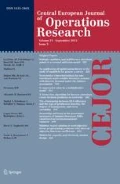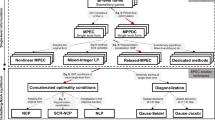Abstract
In this paper, we analytically compare centralized and decentralized market designs involving a national and local market operators, strategic generators having market power and bidding sequentially in local markets, to determine which design is more efficient for the procurement of energy. In the centralized design, used as benchmark, the national market operator optimizes the exchanges between local markets and the generators’ block bids. In the decentralized design, generators act as Stackelberg leaders, anticipating the local market prices and the flows on the transmission lines. Clearing of the local markets can be either simultaneous or sequential. The resulting two-stage game with competitive leaders that are not price takers is formulated as a bilevel mathematical programming problem which is reformulated as a Nash–Cournot game, and conditions for existence and uniqueness of market equilibrium are studied. Imperfect information is also considered, resulting from the lack of incentives from the generators to share their RES-based generations. Through a case study, we determine that the decentralized design is as efficient as the centralized one with high share of renewables, using as performance measure the price of anarchy, and that imperfect information has a limited impact on the efficiency of the decentralized market design. Furthermore, we check numerically that there exists an upper-limit on the block bid length maximizing the social welfare under both centralized and decentralized designs.







Similar content being viewed by others
Notes
Other approaches exist: in lots of markets, exchanges between local markets come from generators within a real-time market (US), or is separately contracted (EU).
By comparison, the EU system relies on zonal pricing, i.e., there is a unique market price per zone (Smeers et al. 2012). The delimitation of the zones, which may contain multiple nodes, is a difficult problem.
An extensive form game describes with a tree how a game is played. It depicts the order in which players make moves, and the information each player has at each decision point (Osborne and Rubinstein 1994).
The national MOs are responsible for the clearing of their local markets. It can happens either simultaneously or sequentially.
The case where generators anticipate transmission link congestion is for example addressed in Cadre et al. (2015).
References
Barquin J, Vazquez M (2003) Cournot equilibrium computation on electricity networks. In: 2nd international workshop on liberalization and modernization of power systems, congestion management problems
Bose S, Cai D, Low S, Wierman A (2014) The role of a market maker in networked cournot competition. In: Proceedings of 53rd IEEE conference on decision and control, pp 4479–4484
Borenstein S, Bushnell J, Stoft S (2000) The competitive effects of transmission capacity in a deregulated electricity industry. RAND J Econ 31(2):294–325
California ISO, Shift Factors: Methodology and Example, CAISO Market Operations. http://www.caiso.com/docs/2004/02/13/200402131609438684.pdf. Online Dec 2016
Cardell J, Hitt CC, Hogan WW (1996) Market power and strategic interactions in electricity networks. Resour Energy Econ 19(1–2):25–60
Chao H-P, Peck SC (1996) A market mechanism for electric power transmission. J Regul Econ 10(1):25–60
Colson B, Marcotte P, Savard G (2007) An overview of bilevel optimization. Ann Oper Res 153:235–256
Dempe S (2010) Annotated bibliography on bilevel programming and mathematical programs with equilibrium constraints. Optim J Math Program Oper Res 52(3):333–359
Dempe S, Dutta J (2012) Is bilevel programming a special case of a mathematical program with complementarity constraints? Math Program 131(1):37–48
Dempe S, Kalashnikov V, Perez-Valdes GA, Kalashnikova N (2015) Bilevel programming problems: theory, algorithms and applications to energy networks. Springer, Energy Systems, Berlin
Economides N, Tag J (2012) Net neutrality on the Internet: a two-sided market analysis. Inf Econ Policy 24:91–104
Ehrenmann A, Neuhoff K (2009) A comparison of electricity market designs in networks. Oper Res 57(2):274–286
Euphemia. https://www.nordpoolspot.com/globalassets/download-center/pcr/euphemia-public-documentation.pdf. Online Sept 2017
Gabriel SA, Conejo AJ, Fuller JD, Hobbs BF, Ruiz C (2013) Complementarity modeling in energy markets. International Series in Operations Research & Management Science
Gonzalez Vaya M, Andersson G (2013) Optimal bidding strategy of a plug-in electric vehicle aggregator in day-ahead electricity markets. In: Proceedings European Energy Market (EEM) conference
Karamardian S (1972) The complementarity problem. Math Program 2:107–129
Kolstad CD, Mathiesen L (1991) Computing Cournot–Nash equilibria. Oper Res 39:739–748
Koutsoupias E, Papadimitriou CH (1999) Worst-case equilibria. In: Proceedings of 16th Annual Symposium on Theoretical Aspects of Computer Science (STACS), vol 1563
Kulkarni AA, Shanbhag UV (2014) A shared-constraint approach to multi-leader multi-follower games. Set Valued Var Anal 22(4):691–720
Le Cadre H (2017) On the efficiency of local electricity markets. In: Proceedings of 14th International Conference on the European Energy Market (EEM). https://doi.org/10.1109/EEM.2017.7981863
Le Cadre H, Papavasiliou A, Smeers Y (2015) Wind farm portfolio optimization. Eur J Oper Res (EJOR) 247(2):560–574
Lieberman MB, Montgomery DB (1988) First-mover advantages. Strateg Manag J 9:41–58
Matamoros J, Gregoratti D, Dohler M (2012) Trading microgrids energy, in islanding mode. In: Proceedings of IEEE SmartGridComm 2012 Symposium, Demand Side Management, Demand Response, Dynamic Pricing
Moré JJ, Rheinbold WC (1973) On P- and S- functions and related classes of \(n\)-dimensional nonlinear mappings. Linear Algebra Appl 6:45–68
Neuhoff K, Barquin J, Maroeska GB, Ehrenmann A, Hobbs B, Rijkers FAM, Vázquez M (2005) Network-constrained Cournot models of liberalized electricity markets: the devil is in the details. Energy Econ 27:495–525
Nisan N, Roughgarden T, Tardos E, Vazirani VV (2007) Algorithmic game theory. Cambridge University Press, Cambridge
Optimate Platform, A numerical simulation platform to recommend new electricity market designs integrating massive flexible generation in Europe. http://www.optimate-platform.eu/. Online Jan 2017
Osborne MJ, Rubinstein A (1994) Course in game theory. MIT Press, Cambridge
Papavasiliou A (2017) Analysis of distribution locational marginal prices, IEEE Transactions on SmartGrid, vol 99. https://doi.org/10.1109/TSG.2017.2673860
Perez-Arriaga I (ed) (2013) Regulation of the power sector. Springer, Berlin
Poli D, Marracci M (2011) Clearing procedures for day-ahead Italian electricity market: are complex bids really required? Int J Energy 3(5):70–77
Purchala K, Meeus L, Van Dommelen D, Belmans R (2005) Usefulness of DC power flow for active power flow analysis. In: Proceedings of IEEE PES General Meeting, pp 2457–2462
Ruiz C, Conejo AJ (2009) Pool strategy of a producer with endogenous formation of locational marginal prices. IEEE Trans Power Syst 24:1855–1866
Schwalbe U, Walker P (2001) Zermelo and the early history of game theory. Games Econ Behav 34(1):123–137
Smeers Y, Oggioni G, Allevi E, Schaible S (2012) Generalized Nash equilibrium and market coupling in the European power system. Netw Spat Econ 12(4):503–560
Stoft S (2002) Power system economics: designing market for power. IEEE Press, Piscataway
Szidarovsky F, Yakowitz S (1977) A new proof of the existence and uniqueness of the Cournot equilibrium. Int Econ Rev 18:787–789
Xu Y, Cai D, Bose S, Wierman A (2015) On the efficiency of networked Stackelberg competition. In: Proceedings of IEEE conference on decision and control
Yao J, Adler I, Oren SS (2008) Modeling and computing two-settlement oligopolistic equilibrium in a congested electricity network. Oper Res 56(1):34–47
Author information
Authors and Affiliations
Corresponding author
Additional information
The author would like to thank the two anonymous referees for their feedback, which have greatly contributed to the improvement of the article content.
Rights and permissions
About this article
Cite this article
Le Cadre, H. On the efficiency of local electricity markets under decentralized and centralized designs: a multi-leader Stackelberg game analysis. Cent Eur J Oper Res 27, 953–984 (2019). https://doi.org/10.1007/s10100-018-0521-3
Published:
Issue Date:
DOI: https://doi.org/10.1007/s10100-018-0521-3




